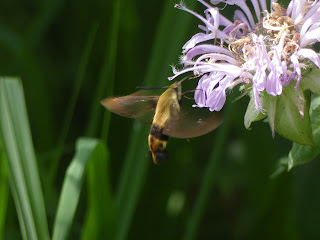Snowberry Clearwing
Here's one of my favorite moths, the Snowberry Clearwing. They're large, diurnal, and can be found nectaring on flowers with other respectable insects. Lots of moths are small, nocturnal creatures that you won't find without special lighting equipment (or sometimes just luck). These moths though can be found just by hanging out where other pollinators hang out.
They're somewhat less common than their Hummingbird Clearwing cousins, who are also largish, diurnal, and can be found in meadows. I don't feel there's much of an aesthetic difference between these two moths, but since the Snowberry Clearwings are a little less common I get a little more excited about seeing them. The Snowberry Clearwing looks a bit more like a big bumblebee while the Hummingbird Clearwing looks a bit more like a female Ruby-throated Hummingbird.
As often happens, Snowberry Clearwings are named after their host plants, the Snowberry shrub, but they're not terribly fussy eaters. They'll eat other plants in the honeysuckle family, and also some plants in the dogbane family (though probably not milkweed). This picture was taken at Duke Farms, where I know they've actively planted some Snowberries, and already have a healthy population of dogbanes. Both of them feed more like hummingbirds though, hovering next to a flower rather than landing on it.
I'm told that they emerge from their cocoons with dark wings, but flap their wings enough that most of the scales fall off, rapidly earning them their "clearwing" names.
 |
| August 5, 2021 at Duke Farms Photo 148952720, (c) jpviolette, some rights reserved (CC BY-NC) |



Comments
Post a Comment